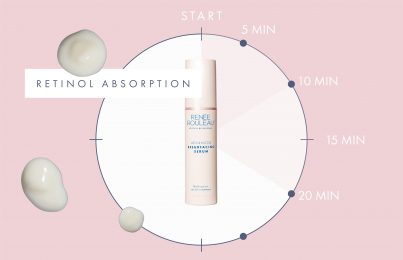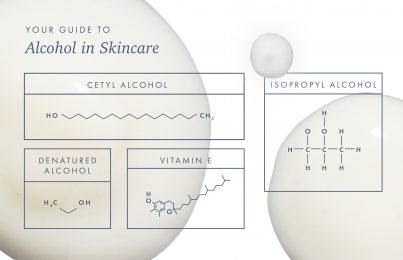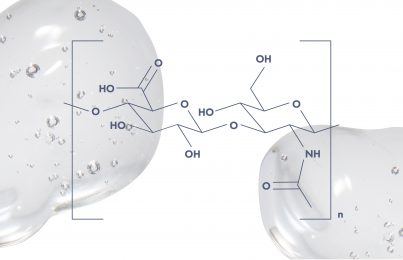Updated 08/24/21. People always ask me, “How long does it take for skincare products to work?” My answer is that it depends on the ingredient you’re using. Even though it can be frustrating to wait for results (especially if you’re putting a lot of time and effort into your routine), you have to remember the old saying, “good things come to those who wait.” Trust me, for some skincare ingredients, this is definitely true! Keep reading to learn which skincare ingredients will give you instant gratification (and which ones are worth the wait).
It’s Not Always Black and White
Before we dive in, I want to talk a bit about expectations. While it’s nice to have a general time frame in mind, it’s often impossible to say exactly how long a specific product will take to make visible changes in your skin. This is because there are tons of variables at play: the form of the ingredient being used (for example, is it a water- or oil-soluble form of vitamin C?), the dose (aka percentage), the base it’s formulated in, and how often you apply it. All of these things will make a difference. Not to mention, an ingredient “working” is relative since everyone has different needs and is looking for different results.
I’ve based the timeframes in this post on a combination of two things—ingredient studies as well as my own experience seeing clients use these ingredients over the last 30 years. With that in mind, remember to take these timeframes with a grain of salt. Now, let’s get started!
The Skin Turnover Cycle
The skin turnover cycle is an important factor in understanding why some ingredients need time to create noticeable differences in the skin. The skin turnover cycle is the process by which the skin renews itself — skin cells are “born” in the base layer of our skin and eventually make their way to the surface where they are sloughed off to make way for newer, fresher cells. When you hear someone refer to skin “turning over,” this is the process they’re talking about.
So how long does this process take? Chances are you’ve heard the skin renews itself on average every 28 days, but this is actually an older school of thought that’s been heavily debated since it was first proposed in the ’70s. More recent research indicates that it likely takes 40-56 days for the skin on the face to turn over. Skin turnover also slows down naturally as we age, which is where skincare comes in handy since some ingredients can help speed this process up.
How Long it Takes Active Ingredients to Show Visible Improvement
Here are six of the active ingredients I get asked about most often and what you can expect when you start using them.
Hyaluronic Acid
I’ll start with hyaluronic acid because of all the ingredients in this post, it gets to work the fastest. As you probably already know, hyaluronic acid is a humectant. It attracts moisture from the environment and binds it to your skin to increase hydration. This gives your skin a nice, plump look. It can even make fine lines appear temporarily less noticeable.
Hyaluronic acid works strictly on the outer layers of the skin, which is why it can get to work in minutes. Larger weights of hyaluronic acid actually form a film over the skin to attract water to the surface, so these start working the fastest. Medium and small molecular weights take a little longer to make their way into the skin, but they still penetrate pretty quickly for dewier, bouncier skin.
The takeaway: Hyaluronic acid gets to work immediately and you may see visibly plumper, more hydrated-looking skin after just a few minutes.
Exfoliating Acids (AHAs and BHAs)
Most people use exfoliating acids in one form or another these days, and one of the reasons people like them so much is their ability to quickly make the skin look brighter and more luminous. While they can definitely provide instant gratification, there are also some longer-term benefits worth sticking around for.
Alpha-Hydroxy Acids (AHAs)
The most popular AHAs used in skincare are lactic and glycolic acid. All exfoliating acids work to dislodge dry, expired skin cells from the skin’s surface so they can be sloughed off. This reveals the fresh new cells underneath, which allows light to be reflected off your skin making it appear brighter. It also helps smooth the texture of the skin to make it feel softer. Because this exfoliating action is happening on the surface of the skin, you get these results pretty instantaneously. You could see results after 5-10 minutes by using an exfoliating peel or see results overnight by applying an exfoliating acid serum. If you’re looking for a truly instant boost in radiance and smoothness, pairing a gentle facial scrub with exfoliating acids can be super effective.
I have seen some research in the past that has shown that if you apply lactic acid three times a week for four weeks, your skin becomes softer and more hydrated, and overall elasticity is improved.
Beta-Hydroxy Acids (BHAs)
Salicylic acid, the BHA used in skincare, gives the same quick exfoliating action you get from AHAs, but it has one notable difference—it’s oil-soluble, so it can penetrate the lining of your pores to clear them out and reduce oil production. It starts doing this almost right away after you apply it, so salicylic acid is a great option if you’re someone whose skin gets oily throughout the day.
If you’re using salicylic acid to manage acne, expect to wait at least four weeks before starting to see real results. It’s also important to note that the more clogged pores you have to begin with, the longer it will take to see the final results. As far as setting proper expectations, remember that acne can be managed but not fully eradicated. It requires a multifaceted approach and while salicylic acid is a great tool, you really need a comprehensive acne routine for your skin type. (In my experience, these are some of the most common causes of adult acne and how to deal with them.)
The Takeaway: Exfoliating acids can make the skin look brighter and feel smoother within minutes or hours, but using them consistently pays off in the long run as well. After four weeks, AHAs like lactic acid can improve hydration and elasticity while BHAs can start to improve blemishes (though depending on the severity of your acne and the number of clogged pores you have, you may need to give it up to three months to see full results).
Retinol
Retinol is really tricky because there are so many different types and strengths available, which really impacts how long it takes to see results. That said, here’s an idea of what to expect when using retinol for acne and for anti-aging benefits.
For Acne
If you’re using a retinol product for acne, chances are you’re getting a prescription retinoid from your dermatologist, so always be sure to follow their instructions and advice. Some studies have shown that retinol can start to improve acne lesions as early as four weeks, but depending on the severity of your breakouts it can take up to three or even six months. I don’t normally recommend retinol for someone who gets red, inflamed breakouts, but if bumpy skin caused by clogged pores is your issue, it can be a great option. (Read more about clearing clogged pores.)
Also keep in mind that when you start using retinol (especially a prescription retinoid), things can get worse before they get better. The skin may get dry or flaky as it acclimates to the product, and acne lesions can actually increase in number as the skin “purges” breakouts that were waiting to come out anyways. Learn how to manage dry, flaky side effects of retinol products.
The Takeaway: It’s been shown that retinol can start to improve acne lesions within four weeks, but depending on the severity of your blemishes it can take as long as three to six months. If you’re unsure about whether or not to stick with a prescription retinoid, consult with your dermatologist.
For Anti-Aging
Retinol is one of the best ingredients you can use for anti-aging, but you’re definitely in it for the long haul. If you’re looking for immediate results, this isn’t for you! Retinol speeds up our skin’s turnover cycle by changing the way our skin behaves at a cellular level, so needless to say it takes some time to take effect within the skin. When using retinol consistently, you might start to see an improvement in skin texture and luminosity within about four weeks. But in my experience, to see the full anti-aging results of a retinol product you need to wait a minimum of three months. Improvements to look for at this point include smaller-looking pores, a decrease in hyperpigmentation for a more even skin tone, and a decrease in fine lines.
The great thing about retinol is that the results keep getting better and better the longer you use it, so once you start you’ll really want to commit. If you have sensitive skin, you may need to start with a lower percentage and work your way up. This means it will take longer to see visible results, but as long as you’re consistent the benefits will be the same in the long run.
The Takeaway: You can usually start to see an improvement in skin texture and luminosity within four weeks, but in my experience, it takes at least three months to be able to judge the full anti-aging results of retinol. Remember, retinol is a marathon, not a sprint!
Niacinamide
Niacinamide is such a versatile ingredient because it can address a wide variety of skin concerns if you give it enough time to do so. Again, how quickly it works for you depends on the percentage you use, how often you apply it, and which problems you’re trying to solve.
One study showed that a 5% niacinamide cream applied twice a day visibly improved redness and blotchiness in the skin in four weeks. Anti-aging effects like wrinkle reduction and improvement in skin elasticity started to kick in after eight weeks. Like retinol, niacinamide works at a cellular level, so it takes some time to show visible effects. For example, one of the ways niacinamide helps increase collagen production is by reducing the propensity of your skin to produce sugar proteins that lead to wrinkles. Naturally, this doesn’t happen overnight.
The Takeaway: Niacinamide at 5% can visibly start to improve redness and blotchiness after four weeks. After eight weeks, you may start to see better skin elasticity and a reduction in fine lines and wrinkles.
Vitamin C
Vitamin C may seem like an ingredient that would start working quickly, but you’ll want to give it more time than you might think. Vitamin C is popular thanks to its ability to brighten the skin, which it does by suppressing melanin activity to help fade discoloration like sunspots, post-breakout marks, or melasma. Studies show it takes four to eight weeks for vitamin C to have an effect on the overproduction of melanin that leads to hyperpigmentation. Since this is a process that takes place at a cellular level, I’ve even seen it take as long as three months for a vitamin C product to really reduce hyperpigmentation and produce a more even skin tone.
It’s also important to remember that hyperpigmentation can be triggered by a variety of things, including heat. Preventing hyperpigmentation requires a multifaceted approach—in addition to using vitamin C, you must wear sunscreen and protective clothing to protect your skin from UV rays, and you should avoid overheating your skin as much as possible. Keep in mind that it’s not always possible to completely get rid of hyperpigmentation, sometimes the best we can do is manage it. All this to say, if your vitamin C doesn’t completely clear it up, that doesn’t mean it’s not working. The goal is to see a visible improvement.
The Takeaway: you may start seeing visibly brighter skin after four to eight weeks but if you’re dealing with lots of hyperpigmentation, give it up to three months to see the full effects of a vitamin C product.
Peptides
Peptides are a really broad class of molecules, so how long it takes to see visible results depends entirely on which kind you’re using. The best way to get this information is usually from the company that sells the product, but keep in mind that their information usually comes from supplier studies. The suppliers are the ones who sell an ingredient, like a peptide, to companies and labs, so it’s worth noting they have a vested interest in making the ingredient look as good as possible. This doesn’t mean the studies aren’t valid, but it’s always important to keep possible biases in mind.
To give you an idea, the supplier that manufactures the peptide acetyl hexapeptide-8 reports that their peptide reduces wrinkle volume and improves skin roughness in 28 days when used twice a day. Most people aren’t applying a peptide serum more than once a day, so I wouldn’t necessarily expect to see results this soon. I’d wait at least three months before judging the overall improvement of your skin. Again, all this work is happening at the cellular level, so you need to give the skin time to respond. Also, keep in mind that peptides are about prevention, so sometimes it’s more about what you don’t see further down the line than what you do see now.
The Takeaway: Peptides are a broad class of molecules, so how long it takes to see a visible improvement in your skin depends on the type you’re using. You can check with the company or supplier, but three months is usually a good rule of thumb. Finally, remember that sometimes it’s about prevention and what counts more is what you don’t see in your skin further down the line.
Final Thoughts
I hope this sheds some light on the question “how long does it take for skincare to work?” As you can see, the answer is usually complicated and, unfortunately, can’t be wrapped up neatly with a bow. However, understanding the way your skin renews itself and that some ingredients work deep within the skin on a cellular level may help explain why it’s not always so black and white.
If you’ve been using a product for a while and don’t feel it’s working for you (and you have realistic expectations), there’s no need to swear off that active ingredient for good. I’d suggest trying different percentages and formulations until you find something that works for you. And finally, always remember that one ingredient can’t do it all! Our skin is complex and needs a variety of things to stay healthy. The key is a well-rounded routine for your skin type that will deliver multiple benefits from multiple ingredients.
Next, learn how using certain ingredients at the same time could be damaging your skin.
Celebrity Esthetician & Skincare Expert
As an esthetician trained in cosmetic chemistry, Renée Rouleau has spent 30 years researching skin, educating her audience, and building an award-winning line of products. Her hands-on experience as an esthetician and trusted skin care expert has created a real-world solution — products that are formulated for nine different types of skin so your face will get exactly what it needs to look and feel its best. Trusted by celebrities, editors, bloggers, and skincare obsessives around the globe, her vast real-world knowledge and constant research are why Marie Claire calls her “the most passionate skin practitioner we know.”



